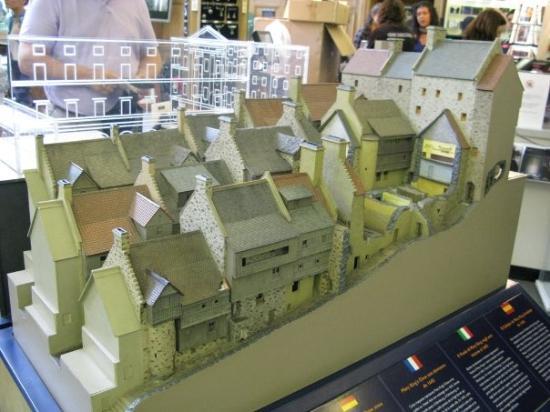Such a tale is the story of Mary King, the “daughter” (some dispute that she was his daughter) of Alexander King, who was advocate for Mary Queen of Scots. Mary was born near the end of the 16th century. She earned enough money to afford a decent lifestyle by sewing garments and selling fine cloths from a shop or stall on the High Street. Mary was also a Burgess in her day, which meant she had voting rights in the city, which was very uncommon in those days.
Since Mary’s husband died after only 13 years of marriage, leaving her with four children, she moved into one of the several tenement properties owned by Alexander King, in what we now know as “Mary King’s Close” where she worked hard as a business-woman to support her family in an incredibly challenging environment.
The narrow alleys on the side of the spine that Mary Kings Close occupies sloped down to a lake, which was really just a cesspool of excrement because the town depended upon rain to wash their waste down to the "lake". One small slip on the narrow lane could send you sliding down the lane and into the disgusting water.
Historical legend says that in a desperate measure to reduce contamination over 300 plague victims were quarantined, probably to die, when Mary King’s Close was bricked up until the plague had passed, giving the alley the nickname “street of sorrows”.
We do know that during plagues, people would have to hang a white rag outside their door if they had the plague and that food would be left outside for them. Those “Physicians” who actually tried to help people, would dress completely in leather and wear masks with long beaks stuffed with herbs to try to protect themselves against the plague.
While beautiful new Georgian structures were being built in New Town, the Old Town was also being modernized. Many of the closes were built over during the renovations of the Old Town.
Our tour leader was the “Spanish Envoy” and he escorted us through a fun and interesting experience down into the bowels of the old close, through what would have been a warren of homes, workrooms, shops. We even visited the remains of what is proposed to be the home of “Annie”, one of the plagues youngest victims. People leave dolls and toys in her honor.
We were finally led out to the narrow, very steep, street, which is now closed over and dark, where we gazed up at the towering tenements, laundry hanaging across the narrow space between the buildings, and imagined we might hear echoes of “garde loo!” from back in the day. The tour is filled with history, fun anecdote and ghostly stories and we loved it!















 RSS Feed
RSS Feed